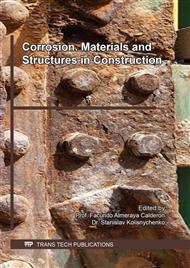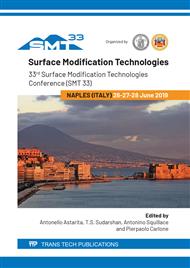[1]
F. Rizzo, M. Barbato, V. Sepe, Peak factor statistics of wind effects for hyperbolic paraboloid roofs, Engineering Structures 173 (2018) 313-330.
DOI: 10.1016/j.engstruct.2018.06.106
Google Scholar
[2]
F. Rizzo, L. Caracoglia, S. Montelpare, Predicting the flutter speed of a pedestrian suspension bridge through examination of laboratory experimental errors, Engineering Structures 172 (2018) 589-613.
DOI: 10.1016/j.engstruct.2018.06.042
Google Scholar
[3]
F. Rizzo, L. Caracoglia, Examining wind tunnel errors in Scanlan derivatives and flutter speed of a closed-box, Journal of Wind and Structures 26 (4) (2018) 231-251.
Google Scholar
[4]
R.W. Drisko, J. F. Jenkins, Corrosion and Coatings: An Introduction to Corrosion for Coatings Personnel, The Society for Protective Coatings, Pittsburgh, USA, (1998).
Google Scholar
[5]
R. Landolfo, L. Cascini, F. Portioli Modeling of Metal Structure Corrosion Damage: A State of the Art Report, Sustainability 2 (2010) 2163-2175.
DOI: 10.3390/su2072163
Google Scholar
[6]
F. Rizzo, G. Di Lorenzo, A. Formisano, R. Landolfo, Time–Dependent Corrosion Wastage Model for Wrought Iron Structures. ASCE's Journal of Materials in Civil Engineering, in print (2019).
DOI: 10.1061/(asce)mt.1943-5533.0002710
Google Scholar
[7]
EN 1993-1-1, Eurocode3: Design of steel structures – Part 1-1: General rules and rules for buildings, European Committee for Standardization (CEN), Brussels, Belgium, (2005).
Google Scholar
[8]
EN ISO 9226, Corrosion of metals and alloys, Corrosivity of atmospheres, Determination of corrosion rate of standard specimens for the evaluation of corrosivity, European Committee for Standardization (CEN), Brussels, Belgium, (1992).
DOI: 10.3403/30209297
Google Scholar
[9]
EN ISO 9224, Corrosion of Metals and Alloys: Corrosivity of Atmospheres: Guiding Values for the Corrosivity Categories, European Committee for Standardization (CEN), Brussels, Belgium, (1992).
DOI: 10.3403/30209291u
Google Scholar
[10]
CEN 12500, Protection of metallic materials against corrosion-Corrosion likelihood in atmospheric environment-Classification, determination and estimation of corrosivity of atmospheric environment, European Committee for Standardization (CEN), Brussels, Belgium, (1998).
DOI: 10.3403/02114553
Google Scholar
[11]
EN ISO 12944-2, Paints and varnishes-Corrosion protection of steel structures by protective paint systems, Classification of environments, European Committee for Standardization (CEN), Brussels, Belgium, (2001).
DOI: 10.3403/30337294
Google Scholar
[12]
C. R. Southwell, J. D. Bultman, C. W. Hummer, Estimating of service life of steel in seawater, in: M. Schumacher (ed.), Seawater corrosion handbook, Noyes Data Corporation, New Jersey, USA, 1979, 374-387.
Google Scholar
[13]
V. Sarveswaran, J.W. Smith Blockley, Reliability of corrosion-damaged steel structures using interval probability theory, Structural Safety 20 (3) (1998) 237-255.
DOI: 10.1016/s0167-4730(98)00009-5
Google Scholar
[14]
R. E. Melchers, Corrosion uncertainty modelling for steel structures, Journal of Constructional Steel Research 52(1) (1999) 3-19.
DOI: 10.1016/s0143-974x(99)00010-3
Google Scholar
[15]
N. Yamamoto, K. Ikegami, A study on the degradation of coating and corrosion of ship's hull based on the probabilistic approach, Journal of Offshore Mechanics and Arctic Engineering 120(3) (1998) 121-128.
DOI: 10.1115/1.2829532
Google Scholar
[16]
J. K. Paik, A. K. Thayamballi, Y. I. Park, J. S. Hwang, A time-dependent corrosion wastage model for seawater ballast tank structures of ships, Corrosion Science 46 (2004) 471-486.
DOI: 10.1016/s0010-938x(03)00145-8
Google Scholar
[17]
J. K. Paik, K. Kim Do, Advanced method for the development of an experimental model to predict time-dependent corrosion wastage, Corrosion Science 63 (2012) 51-58.
DOI: 10.1016/j.corsci.2012.05.015
Google Scholar
[18]
Mohd M. H., Paik J. K., 2013. Investigation of the corrosion progress characteristics of offshore subsea oil well tubes, Corrosion Science 67 (2013) 130–141.
DOI: 10.1016/j.corsci.2012.10.008
Google Scholar
[19]
R. Loseth, G. Sekkeseter, S. Valsgard, Economics of high tensile steel in ship hulls, Marine Structures 7 (1994) 31–50.
Google Scholar
[20]
C. Guedes Soares, Y. Garbatov, Reliability of Maintained, Corrosion Protected Plates Subjected to Non-Linear Corrosion and Compressive Loads, Marine Structures 12 (6) (1999) 425–445.
DOI: 10.1016/s0951-8339(99)00028-3
Google Scholar
[21]
S. Qin, W. Cui, Effect of corrosion models on the time-dependent reliability of steel plated elements, Marine Structure 16(1) (2003) 15-34.
DOI: 10.1016/s0951-8339(02)00028-x
Google Scholar
[22]
W. C. Cui, X. D. Xu, Q. Qiu, A fast method to calculate the mean and standard deviation of the function of random variables (in Chinese), Journal of Ship and Ocean Technology 2(6) (1998) 50–60.
Google Scholar
[23]
P. Albrecht, T.T. Hall, Atmospheric corrosion resistance of structural steels, Journal of Materials in Civil Engineering 15(1) (2003) 2–24.
Google Scholar
[24]
R. Fratesi, The steel corrosion, mechanisms and protection methods (in Italian). Proceedings of the Promozione acciaio Conference L'acciaio nell'edilizia sociale, sportive e del tempo libero,, Bari, Turin and Rome, ACS ACAI SERVIZI srl, Milan, Italy, (2002).
Google Scholar
[25]
G. Di Lorenzo, E. Babilio, A. Formisano, R. Landolfo, Innovative steel 3D trusses for preservating archaeological sites: Design and preliminary results, Journal of Constructional Steel Research 154 (2019) 250-262.
DOI: 10.1016/j.jcsr.2018.12.006
Google Scholar
[26]
F. P. Boubèe, Theoretical-Practical elementary Treaty of Metallic Constructions (in Italian), Pellerano, Naples, Italy, 1880.
Google Scholar
[27]
G. K. Geerlings, Wrought Iron in Architecture: An Illustrated Survey (Dover Jewelry and Metalwork), Dover Publications, New York, USA, (1984).
Google Scholar
[28]
G. A. Breymann, O. Koniger, Civil constructions: Vol. III: Iron constructions (in Italian), Vallardi, Milan, (1925).
Google Scholar
[29]
Modena C., Lourenço P.B., Roca P., 2004. Structural Analysis of Historical Constructions - 2 Volume Set: Possibilities of Numerical and Experimental Techniques - Proceedings of the IV Int. Seminar on Structural Analysis of Historical Constructions, 10-13 November 2004, Padova, Italy, ISBN 9780415363792.
DOI: 10.1201/9781482288377
Google Scholar
[30]
G. Di Lorenzo, A. Formisano, R. Landolfo, On the origin of I beams and quick analysis on the structural efficiency of hot-rolled steel members, The Open Civil Engineering Journal 11(Suppl-1, M3) (2017) 332-344.
DOI: 10.2174/1874149501711010332
Google Scholar



